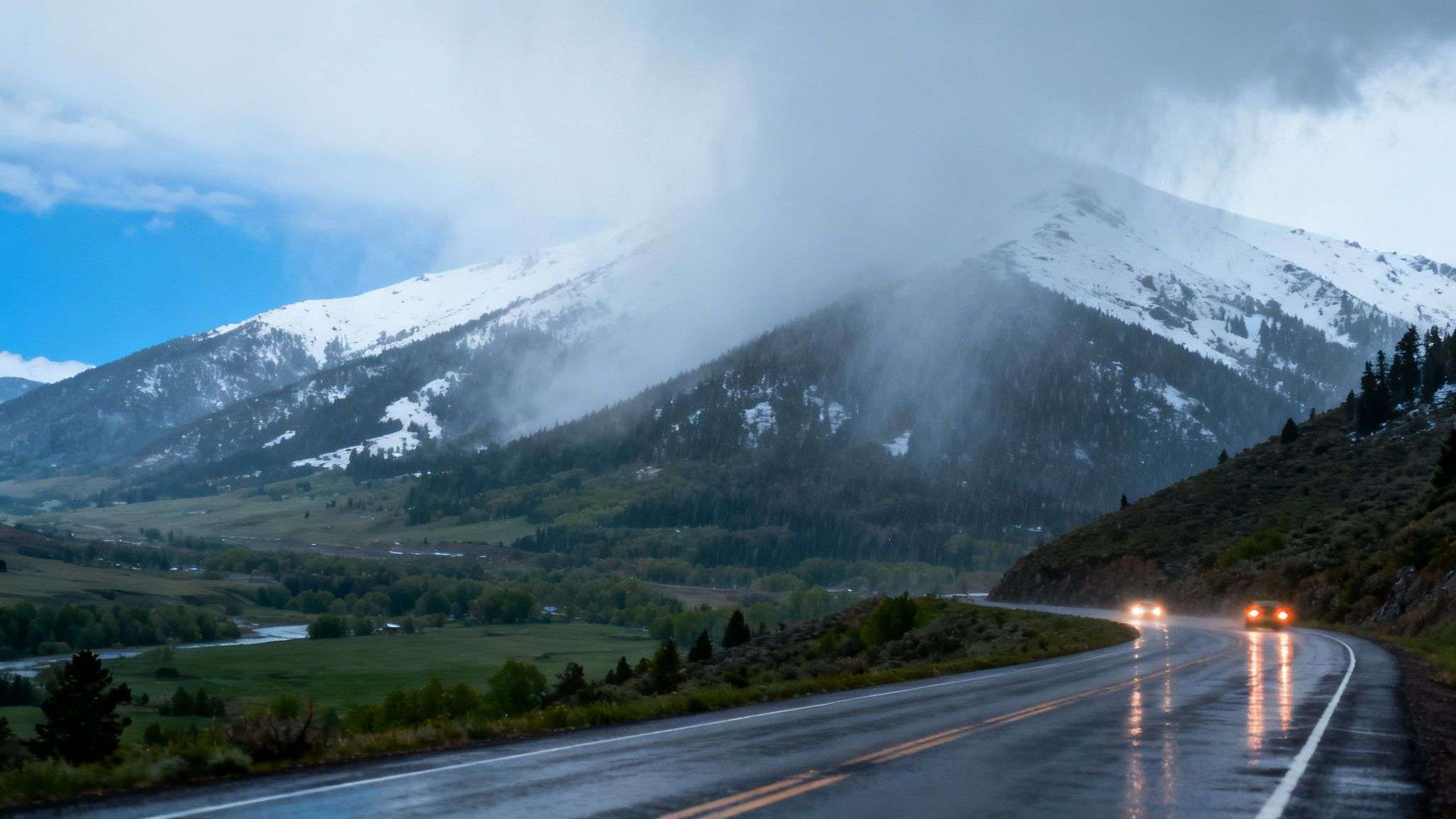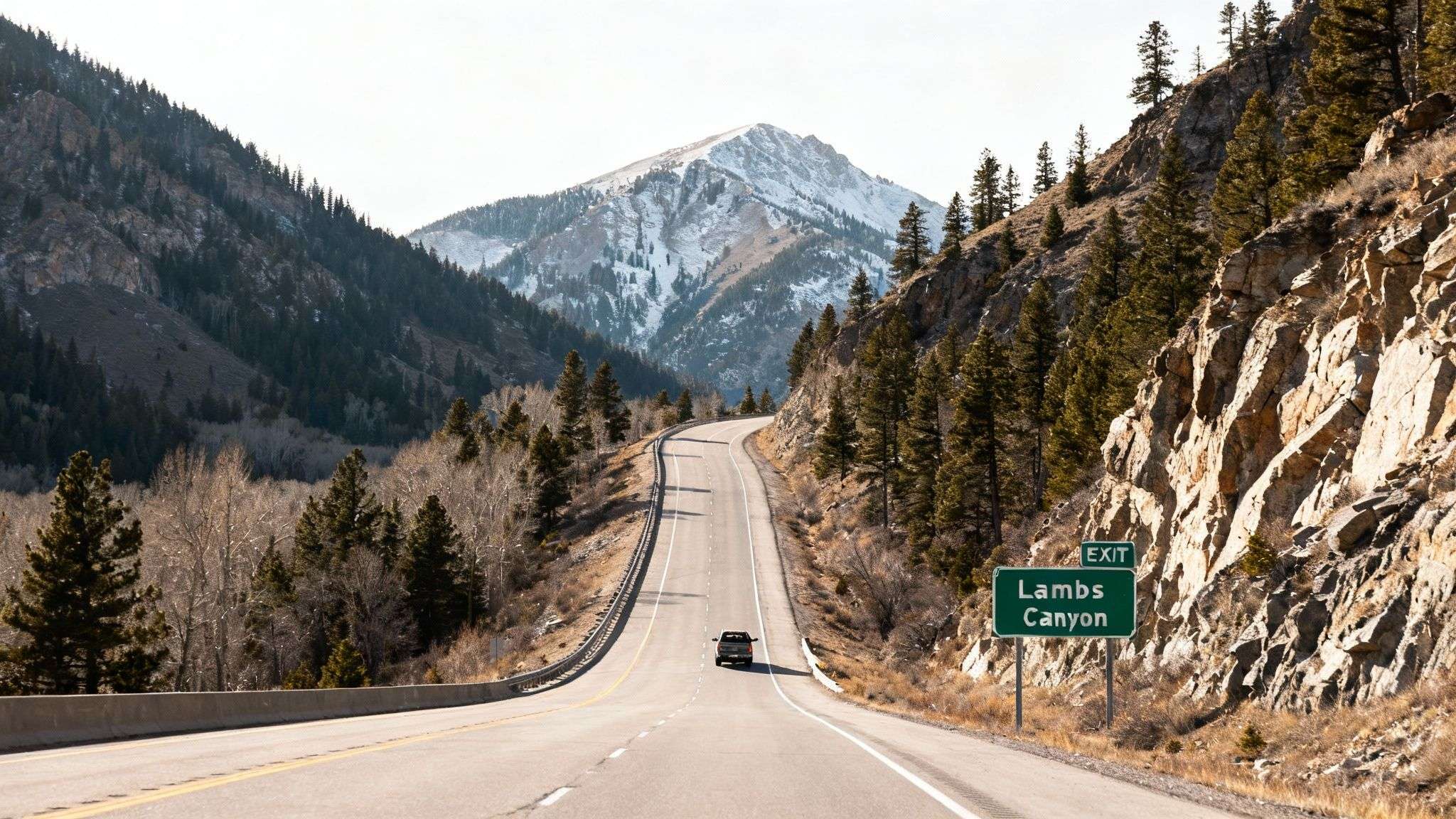A Driver's Guide to Parleys Canyon, Utah
Your guide to safely navigating Parleys Canyon, Utah. Get live data, tips on traffic, weather, steep grades, and traction laws for I-80.
Parleys Canyon is a high-altitude mountain pass on I-80 that demands respect from every driver. Known for its steep 6% grades, unpredictable weather at the 7,120-foot summit, and heavy ski traffic, a safe trip requires planning. This guide provides actionable, local tips on what to expect, when to travel, and how to drive safely through this vital corridor between Salt Lake City and Park City.
What to Expect on the Road
Driving through Parleys Canyon is a mountain adventure, not a typical highway cruise. This stretch of I-80 is defined by its challenging terrain, variable weather, and heavy traffic flow, especially during peak seasons. Knowing what you're up against is the first step to a smooth journey.
Here’s a breakdown of the key challenges:
- Steep Grades: From Salt Lake City, you'll climb a sustained 6% grade for about 12 miles to the summit. Heading down requires careful speed management to avoid overheating your brakes. Big rigs move slowly in the right lanes for a reason.
- Wild Weather Swings: The high elevation creates its own weather system. A clear day in the valley can be a blizzard at the summit, with conditions changing from dry pavement to a whiteout in just a few miles.
- Heavy Traffic: Expect significant congestion during morning and evening commutes. On winter weekends, ski traffic transforms the canyon into a slow-moving parking lot, causing major backups that can last for hours.
When to Drive Through Parleys Canyon
Timing is everything in Parleys Canyon. The difference between a smooth 20-minute drive and a two-hour crawl often comes down to when you leave. Traffic follows predictable patterns tied to daily commutes and seasonal recreation.
Navigating Peak Traffic Times
All it takes is one accident during peak hours—like a jackknifed semi—to shut the whole canyon down. Planning your travel outside of these windows is the single best way to avoid delays. Our live data shows clear patterns you can use to your advantage.
Parleys Canyon Traffic Patterns by Time and Season
| Time / Season | Weekday Traffic | Weekend Traffic | Actionable Tip |
|---|---|---|---|
| Morning Rush | Heavy eastbound (7 AM - 9 AM) with commuters heading toward Park City. Westbound is generally clear. | Very Heavy eastbound (starting 6:30 AM) with ski traffic. Expect significant delays on powder days. Westbound is light. | On a winter weekend, be at the mouth of the canyon by 7:00 AM to beat the worst of the ski rush. |
| Midday | Light in both directions. The best window for travel between 10 AM and 3 PM. | Moderate in both directions with recreational traffic. Generally a good time to travel. | This is the sweet spot for errands or appointments in either Park City or SLC. |
| Afternoon Rush | Heavy westbound (4 PM - 6:30 PM) as commuters return to Salt Lake. Eastbound is clear. | Very Heavy westbound (3 PM - 6 PM) as skiers head home. The "red snake" of taillights is common. Eastbound is light. | Leave the ski resort before 2:30 PM or stay for dinner and leave after 6:30 PM to avoid the downhill gridlock. |
| Summer / Off-Season | Follows standard commuter patterns but with less intensity than in winter. | Can be busy with hikers, bikers, and campers, but backups are far less common than during ski season. | Holiday weekends like the Fourth of July or Labor Day will see a major increase in recreational traffic. Plan accordingly. |
The Unpredictable Canyon Weather
Parleys Canyon plays by its own weather rules. A sunny forecast for Salt Lake City doesn't guarantee clear conditions at the 7,120-foot summit. For a deeper dive into the specific weather phenomena that affect local mountain passes, check out our guide on understanding Wasatch weather patterns.
Local Tip: Always check a forecast specifically for the Parleys Summit area, not just Salt Lake City or Park City. This gives you a much more accurate picture of the conditions you'll actually face during the most challenging part of your drive.

How to Drive Parleys Canyon Safely
Safe passage through Parleys Canyon requires preparation and the right driving techniques, especially when winter weather hits. Following these rules and tips isn't just about your own safety—it helps keep traffic flowing for everyone.
Master Utah's Traction Law
When a winter storm rolls in, UDOT will often activate the Utah Traction Law. This is a legal requirement, not a suggestion. Ignoring it can result in a hefty fine and, more importantly, a dangerous accident.
- At a minimum, your vehicle must have M+S (Mud and Snow) rated tires.
- For severe conditions, 3-Peak Mountain Snowflake (3PMSF) tires are highly recommended for their superior grip.
- Your vehicle must also have 4WD or AWD, or you must have traction devices like chains available.
Adopt Mountain Driving Techniques
The steep grades in Parleys put significant stress on your vehicle. Use these techniques to stay in control:
- Use Engine Braking: When descending from the summit, downshift to a lower gear (L, 2, or 3) instead of riding your brakes. This lets the engine control your speed and prevents your brakes from overheating and failing.
- Increase Following Distance: Maintain at least a four-second gap between you and the car ahead. In wet or snowy conditions, increase that distance even more to give yourself adequate time to react.
- Watch for Wildlife: Parleys is a major wildlife corridor. Be extra vigilant for deer and elk crossing the interstate, especially at dawn and dusk.
Pack a Canyon Emergency Kit
A single accident can shut down the canyon for hours. Always be prepared for a long delay.
- For You: Pack extra water, non-perishable snacks, warm blankets, and a first-aid kit.
- For Your Car: Include jumper cables, a small snow shovel, an ice scraper, and traction mats or cat litter for icy spots.
Understanding the Parleys Canyon Route
Knowing the key landmarks along I-80 helps you build a mental map and track your progress, which is especially useful in poor visibility.
Key Landmarks and Exits
- Exit 132 (Foothill Drive/Parleys Way): Marks the beginning of the canyon as you leave the Salt Lake Valley.
- Exit 134 (East Canyon/Little Dell Recreation Area): A popular turnoff for scenic drives and recreation.
- Exit 140 (Lambs Canyon): Access to residential areas and quiet hiking trails. Seeing this exit means you're nearing the summit.
- Exit 141 (Jeremy Ranch): A sign that you're descending from the summit toward Park City.
This route has been a critical transportation artery for over a century, evolving from Parley P. Pratt's "Golden Pass Toll Road" into the modern interstate we drive today. You can still spot remnants of the old Denver & Rio Grande Western Railroad cuts—a cool reminder of the engineering challenges overcome to traverse this landscape. You can explore more of the fascinating canyon's transportation evolution on UtahRails.net.

Recreation in Parleys Canyon
Beyond the interstate, Parleys Canyon is a recreational hub offering a quick escape into the Wasatch Mountains. Trailheads and parks tucked just off the highway provide easy access to hiking, biking, and dog-friendly trails.
- Parleys Summit West Trailhead: A popular starting point for mountain bikers and hikers accessing the Great Western Trail right at the top of the pass.
- Lambs Canyon Trail: A shady, secluded hiking trail off Exit 140 that follows a creek, making it a favorite during hot summer months.
- Mount Aire Trail: A steep, challenging climb that rewards hikers with panoramic 360-degree views of the canyon and surrounding peaks.
- Parleys Historic Nature Park: Located at the canyon mouth, this 68-acre park offers gentle, off-leash dog-friendly trails along Parleys Creek. Learn about the history and preservation of Parleys Creek.
FAQ: Driving Parleys Canyon
Are chains required in Parleys Canyon? Chains are generally not required for passenger vehicles on I-80. However, when the Traction Law is in effect during winter storms, your vehicle must have proper snow tires (M+S or 3PMSF) and either 4WD/AWD or on-board traction devices like chains.
What should I do if the canyon closes while I'm in it? Stay in your vehicle and follow instructions from the Utah Highway Patrol. They will direct traffic and work to clear the road. Having an emergency kit with water, snacks, and blankets is crucial, as closures can last for several hours.
For the most current, real-time traffic and weather information for all your Wasatch mountain adventures, trust Wasatch Travel Helper. Plan your trip with live camera feeds and accurate data at https://wasatchroads.com.